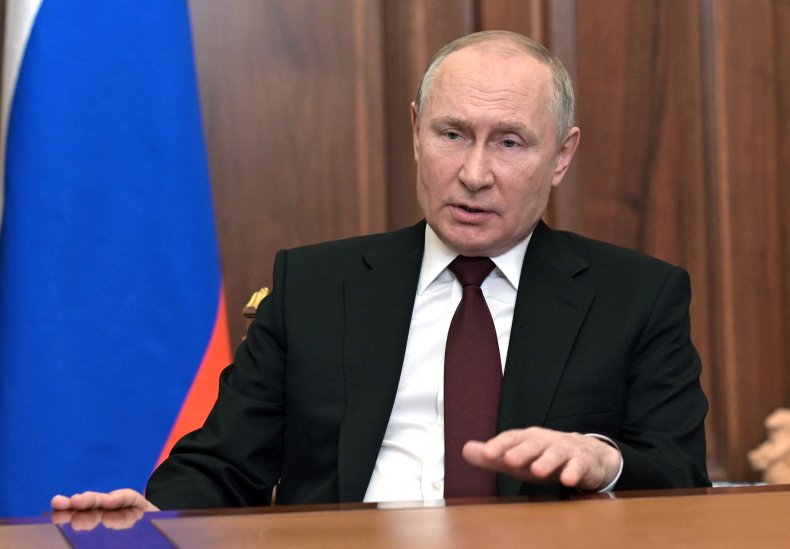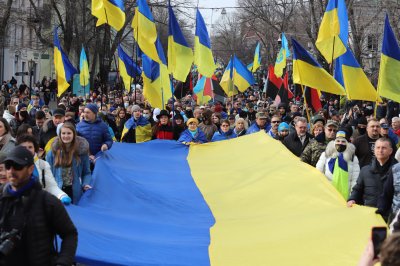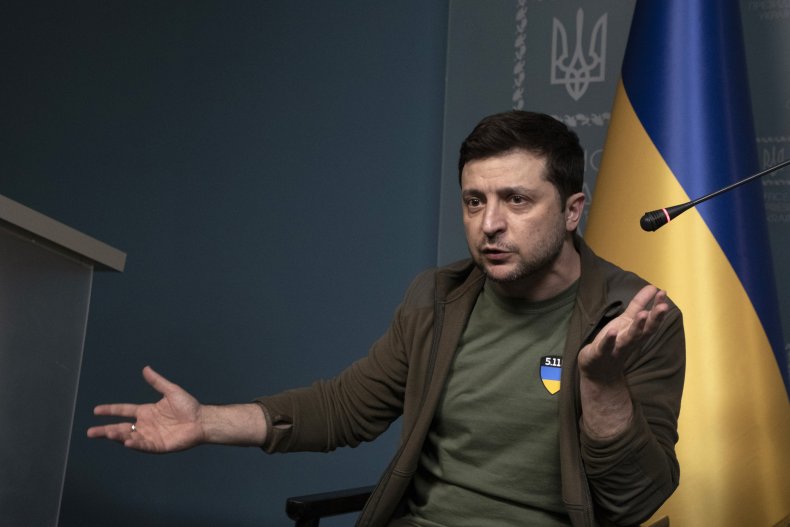
Nuclear Fears Intensify As Ukraine War Builds. What Is Putin’s Threshold?
By Fred Guterl On 3/6/22 at 5:00 AM EST
News of Russian tanks running out of gas and soldiers scrounging the countryside for food was good news in the early days of the war. But apparent weaknesses in the Russian military, and in President Vladimir Putin‘s standing abroad and at home, could increase the chance that Russia resorts to nuclear weapons in the conflict, military experts say.
Russia already escalated the conflict when its forces failed to make quick work of the Ukrainian military with intense and indiscriminate attacks on civilian targets. If Russia’s campaign stalls again, nuclear weapons could wind up being a fallback option for Putin.
“If the Russian campaign starts to feel like it’s a military catastrophe, that’s where escalation to nuclear weapons comes into play,” says Barry Posen, Ford International Professor of Political Science at MIT.
Military experts interviewed by Newsweekbelieve that such a nuclear conflagration is not likely at this point. Although Putin announced that Russia’s nuclear forces have been placed into “special combat readiness” and made an implicit threat to use them against “whoever tries to interfere with us,” he probably intended the tough talk to deter NATO from sending troops or planes into the battlefield, analysts say.
The notion that nuclear war, despite the situation in Ukraine, is still a low-probability event offers little solace, however. “Probability is the wrong concept to apply to this situation,” says Pavel Podvig, a senior researcher at the United Nations Institute for Disarmament research in Geneva, Switzerland. “What seems impossible now could in fact happen. This war is a one-off irreproducible event.”
Little is known about the dynamics of nuclear escalation on the battlefield. The only experience of nuclear weapons being used in a conflict came in August 1945, when the U.S. dropped two bombs on Japan at the end of the Second World War. There are no reliable assessments of the risk of a battlefield nuclear exchange escalating into a wider conflict involving Russia and the U.S., who each have thousands of nuclear-tipped intercontinental ballistic missiles aimed at one another.
At issue in Ukraine is not so much ICBMs as “tactical” nuclear weapons delivered on short or medium range missiles. Russia is thought to have about 2,000 of these weapons, many of them available for use in Ukraine. Although the U.S. and its allies have been adamant about staying on the sidelines to avoid a direct confrontation with Russian forces, military experts see many scenarios in which the Ukraine conflict could degenerate to the point where Russia deploys a nuclear weapon. A mistake or misunderstanding of some sort—such a Russian plane crossing into NATO territory or a NATO plane into Ukraine airspace—could bring the nuclear superpowers into direct conflict, leading Russia to use one of its tactical nukes.
Although the nuclear threat seemed to fade from public view after the fall of the Berlin Wall in 1989 and the collapse of the Soviet Union, Cold-War-style nuclear fears are once again front and center. Ukraine is unlikely to be the last conflict between the so-called Great Powers—the U.S., China and Russia—that takes place under the cloud of potential nuclear war. It’s not hard to imagine other conflicts arising on Russia’s western border or off China’s eastern coast in the not-too-distant future.
“Nuclear weapons are back, but they never really went away,” says Caitlin Talmadge, Associate Professor of Security Studies at Georgetown University. “What’s new in the present era is that the three great powers with nuclear weapons are entering a period of renewed competitive relationships. We’re talking about a world where in peacetime, in crisis and in conflict there is a nuclear shadow over states’ interactions.
“We’re getting a preview of that shadow in this war.”

Nuclear threshold
Putin has already taken the first step by escalating the conflict with conventional forces. He may initially have thought that the government in Kyiv would topple quickly and collapse without much of a fight. When Russian forces encountered resistance, he needed a way to break the stalemate. His use of missiles and mortars against civilian targets may be a prelude to laying siege to major cities in Ukraine, which would leave civilians trapped without access to food, water and power, with the goal of ratcheting up pressure on the Ukrainians and the West to come to terms.
The threshold for Putin’s use of tactical nukes, should this plan go awry, is difficult to gauge, military scholars say. A decision to use nukes would take into account domestic Russian politics, international politics and the state of the campaign in Ukraine. If Putin can maintain control of the home front, either by suppressing dissent or because Russians acquiesce to the war; if fissures arise in the Western coalition; and if Russia’s Ukraine campaign goes smoothly from here on out, there’d be no need for a nuclear option. But if demonstrators in Moscow take to the streets, and Ukraine continues to stave off the assault, and NATO stands united, Putin could be backed into a corner. He could make the cold-hearted calculation that a few tactical nukes couldn’t make his position any worse, and just might make it better.
This logic may be evil, but it is not Putin’s invention. Something similar has been standard military doctrine for decades. During the Cold War, NATO’s nuclear posture was to use nuclear weapons as a last resort in repelling what was then perceived as overwhelming Russian conventional forces in Europe. The same is true for Pakistan’s nuclear strategy against the superior conventional forces of India, and for North Korea’s against the forces of South Korea and the U.S. Inferiority in conventional forces is a major reason nations want nuclear weapons in the first place.
Spillover
An escalation doesn’t necessarily have to result from a well-thought-out decision. It could happen inadvertently—the result of a moment’s misunderstanding or miscalculation.
For instance, as the war intensifies and Western nations continue to funnel arms to the Ukrainians, the risk of an encounter with the Russian military rises. When Putin threatened to go nuclear against anyone who intervenes, did he have in mind supplying arms via the western border of Ukraine? What about NATO trainers and support personnel assisting with weapons, tanks and fighter jets?
If the war goes badly for Russia and its generals believe that the supplies coming in from the west are a problem, they could seek to interdict them by running airstrikes along the Polish, Slovakian and Romanian borders. That would bring Russian jet fighters close to NATO’s borders. It’s not hard to imagine a Russian plane shooting at a NATO target by mistake, which would greatly escalate the conflict.
What, then, would NATO do? With Russia looking like it could lose the war, does it give in to the entreaties by President Zelensky and others to create a no-fly-zone over Ukrainian territory? That would immediately escalate the conflict to one between NATO and Russia. “This all sounds like fantasy,” says a military analyst who prefers to remain anonymous. “It’s not fantasy now. This is all very possible.”
Misunderstandings have flared up into accidental engagement before. During a period of heightened concern over nuclear conflict, the Soviet Union shot down a Korean passenger liner in 1983, killing hundreds of civilians. Iran shot down a civilian airliner in early 2020 shortly after the U.S. assassinated Qasem Soleimani of Iran. In 2014, a Malaysian airliner was shot down over eastern Ukraine.

Even though Russia’s nuclear threats are most likely meant as deterrence, they also have a self-fulfilling aspect—they can lead to “cycles of action and reaction on both sides,” says Talmadge. Surrounding NATO states may respond by deploying troops and weapons to their eastern borders and putting them on high alert. If the Baltic states, which are vulnerable to a Russian ground attack, move troops and weapons to forward positions on the border, Russians could read that as offensive in intent. Tensions rise, a shot is fired, and suddenly Russia and NATO are in conflict.
“I don’t like the discussions I’m hearing from the fringes of the establishment,” says Posen. “I don’t like the emotions running hot. I don’t like the weird appearance on our side, way too early, of a kind of victory disease: ‘Let’s win this thing. Maybe Putin will fall’.”
Despite Putin’s talk about putting his nuclear forces on alert, so far there is no evidence that it has taken its tactical nukes out of storage and moved them to their delivery vehicles, says Olga Oliker, a Russia expert and director of the Europe and Central Asia Program at the International Crisis Group.
“If I see Russia moving its nuclear weapons in a way that suggests they’re planning a strike on something, I will worry very very much,” she says. “We should be very reassured by the fact that there is no evidence that Russia has changed anything about its alert status.”

Aftermath
The action in Europe could presage rising nuclear tensions around the world. Oliker worries that Western nations will walk away from the conflict feeling that they screwed up and resolve, the next time a superpower gobbles up a smaller nation, to fight. “There’s going to be the clamor that Ukraine was a Munich, that we made a mistake,” she says.
In Europe, the response may be to build up NATO forces in Europe and prepare for a future conflict with Russia, which would raise the risks for a high-stakes confrontation. “The risk that a war between NATO member states and Russia goes nuclear is real,” she says.
China’s leaders, meanwhile, may be watching Russia’s Ukraine campaign with thoughts of Taiwan. Last year, China reportedly tested missile technology that could conceivably deliver a nuclear warhead to the United States from the south, beyond the scope of the U.S.’s northward-pointing ICBM early-warning radar. Beijing denied the reports.
The nuclear posturing continues.
Correction (3/6/22, 12:07 EST): A previous version of this article incorrectly stated Olga Oliker’s title. She is director of the Europe and Central Asia Program at the International Crisis Group.
No comments:
Post a Comment